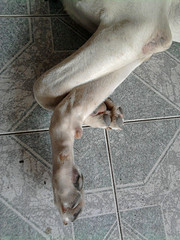Unsightly calluses on dog's legs and elbows are common, no cause for alarm

Don't fret about calluses.
flickr photo courtesy of Honou
I tried in vain to keep her from laying on the hard sidewalk when she was out in the backyard, where there was soft grass to lie in; or on the kitchen floor, where the hard surface wreaked havoc on those points of contact on her body.
She would have none of it. Despite my pleas for her to nest on her cushy doggy beds inside and more comfortable areas outdoors, she always preferred hard, seemingly uncomfortable surfaces.
I was disheartened, but took it in stride.
One of her elbows has become more callused than the other, as she has a habit of proppng herself up on that pressure point.
To this day, planting herself on a cool, dirty concrete floor in the garage is most inviting. Go figure.
I resigned myself to the fact that once they formed, they weren't going away. I tried to minimize them, but to no avail. Gretchen's calluses are as much a part of her as her other physical attiributes are.
One thing that I learned very early was that there is no treatment for them. The only solution is to try and help your pet avoid getting them. They're more common in large-breed dogs, so offering soft alternatives in your pooch's favorite spots to hang out is helpful, especially if they have an outdoor pen.
Suggested remedies, like balms or aloe vera, can help improve the look of the calluses, but this might do more harm than good. Softening the toughened area can lead to the skin being compromised, causing abrasions or cracks — plus it will be tender to the touch.
Calluses actually help to protect the area from damage, so it's best to leave them alone. Have a look at them periodically to ensure that they aren't irritated, though. If your dog starts licking or chewing at them, see your veterinarian immediately.
Read more on calluses from HealthPet.com here.
Lorrie Shaw is lead pets blogger for AnnArbor.com and has written about ways to keep your pets healthy. Follow her writing and pet-related adventures on Twitter @psa2 and contact her via e-mail.

